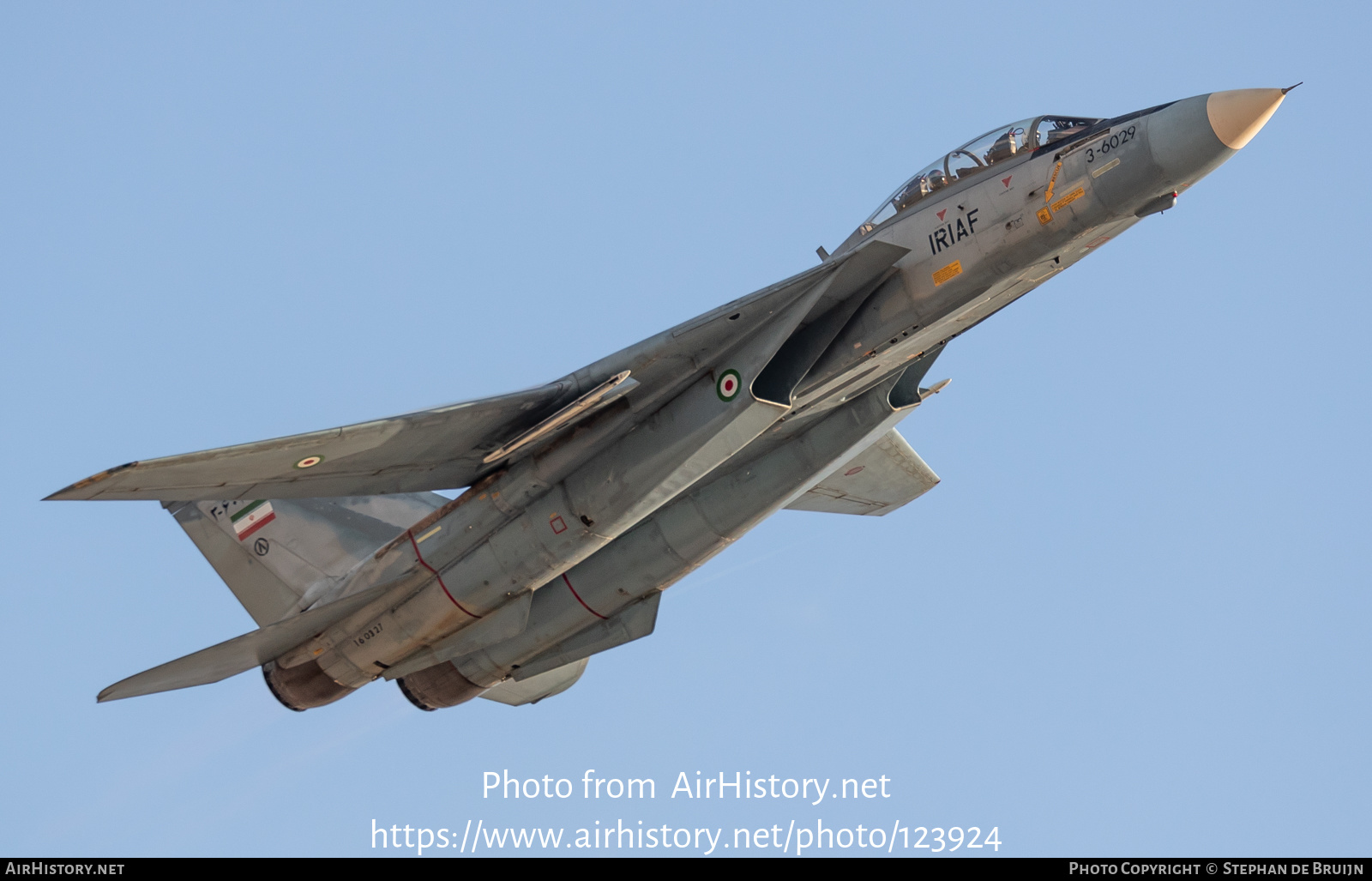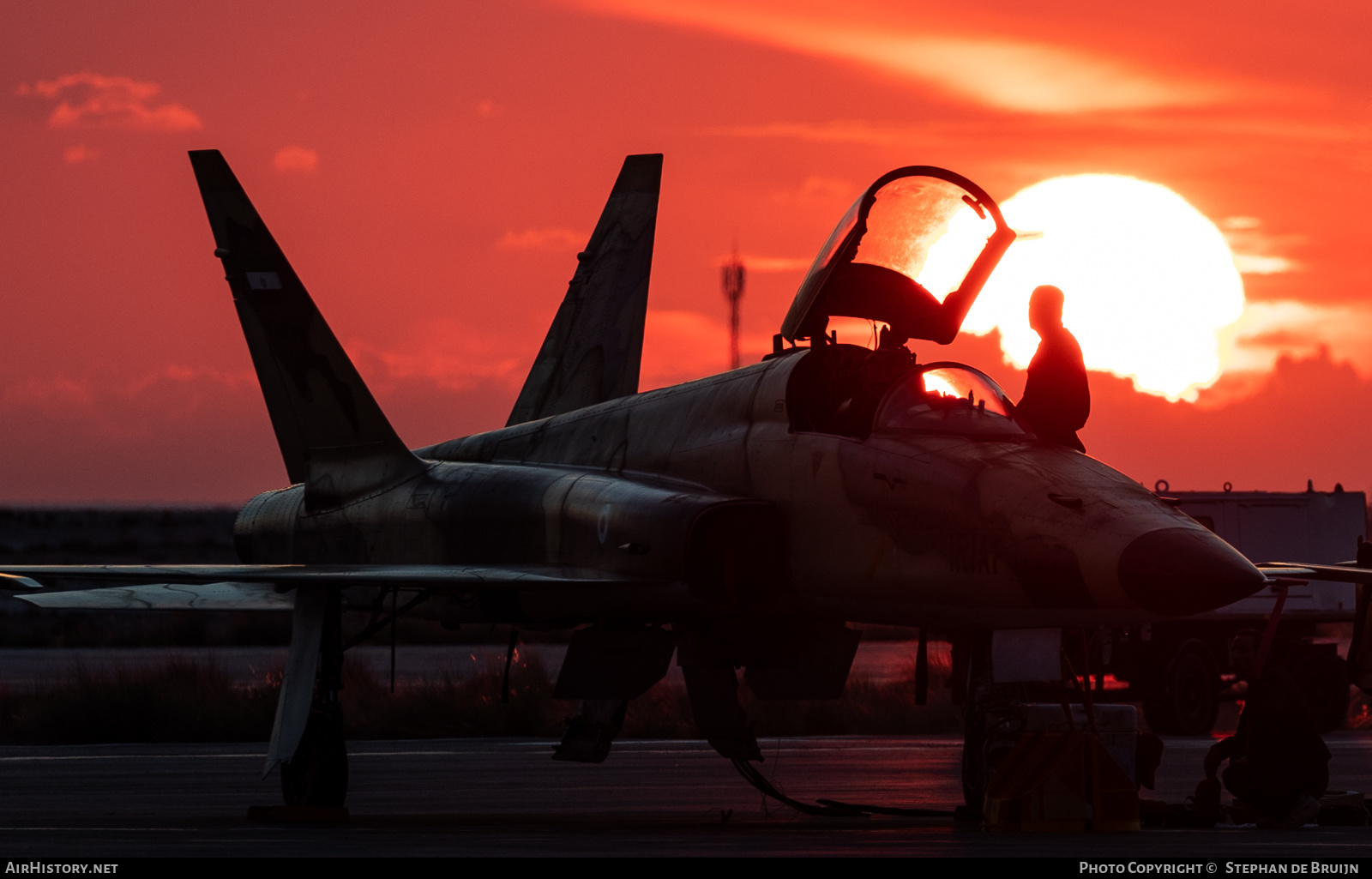Iran Airshow 2018
displays Iranian airpower
By Stephan de Bruijn 7 April 2019
The ninth edition of the Iran Airshow on Kish Island, a tiny free trade zone in the Persian Gulf, was one to remember. In contrast to the earlier shows, the Iranian armed forces attended the 2018 event in force.
Persian Cat! Twelve F‑14s are reported to be airworthy with the Iranian Air Force.
Photo: Stephan de Bruijn
The Iran Airshow 2018 was held from 26 to 29 November 2018, and with such a strong participation by the Iranian military, it can be considered historic in the same way as the Libyan Aviation Expo (LAVEX) at Tripoli in 2009 and the Wonsan Air Festival in North Korea in 2016.
In 2016, the bi-annual show at Kish was already attended by Islamic Republic of Iran Air Force (IRIAF) front-line aircraft such as the indigenously developed, twin-tailed F‑5E/F Saeqeh; the mighty MiG‑29 Fulcrum; a C‑130 Hercules executing an airdrop; three F‑4 Phantoms trailing a Boeing 707; and last but not least, an F‑14AM Tomcat in a dogfight with a MiG‑29 over the field. The 2016 edition also witnessed the L‑39s of the Baltic Bees aerobatic team, as well as the Su‑27s of the Russkiye Vityazi (Russian Knights).
The show made great progress in 2018. When arriving at the airfield, visitors were treated with a small static display in front of the civil terminal. Seen here were an IRIAF F‑14A Tomcat, F‑5F Saeqeh, PC‑7, and C‑130E Hercules; an Islamic Republic of Iran Navy (IRIN) SH‑3D Sea King; and an Iranian Revolutionary Guard Corps (IRGC) Tucano, Mil Mi‑171 and Harbin Y‑12. At the flight line were more aircraft destined for the flying display; two F‑5E Saeqehs, three Tucanos and a PC‑7, a Y‑12, six L‑39s of the Baltic Bees, and seven MiG‑29s of the Russian Strizhi (Swifts), plus their supporting, but non-flying Il‑76.
As the Iran Airshow is also an international trade exhibition, a large hall housed some 110 stands where companies presented their stuff, including reverse engineering skills, flight simulators, and various unmanned aerial systems – fixed-wing and multi-rotor, for surveillance and reconnaissance or armed. There were also space presentations, airline companies, flying schools, and so on. Iran Helicopters showed, among other, civil choppers, a military registered Bell 214, indigenously modified as a fully equipped Emergency Medical Services (EMS) helicopter.
On each of the four days, the gates were opened at noon for the public to enjoy the show. Aircraft engines were started up at around 3 pm. The first noise was of a Harbin Y‑12 that dropped a free-fall parachute display team high over the field, with one of the jumpers proudly flying a huge Iranian flag attached to his feet. The Revolutionary Guard has twelve Chinese-built Y‑12/Y‑12‑II aircraft. They are based at Shiraz, but they are often deployed to locations throughout the country, including the Persian Gulf coastal area where they fly maritime surveillance missions and provide logistic support to the small Iranian islands in the area.
With the parajumpers on the ground, smoke trails appeared low over the horizon behind the Kish coastline with its hotels and carcasses – due to the economic sanctions against Iran, there are many unfinished buildings with many construction cranes standing unemployed. Those smoke trails were created by two Sukhoi Fitters of the IRGCAF, a Su‑22M4 and a Su‑22UM‑3K. The aircraft did two spectacular formation flybys, followed by a split-up so each Su-22 could perform an airfield attack that came with a 360 degrees roll.

Each day at the 2018 Iran Airshow, two Islamic Revolution Guards Corps Air Force Su‑22s performed a mock attack at Kish. These attack jets were operating out of nearby Bandar Abbas, although they are normally based at Shiraz. Here the two-seater Su‑22UM3K 15‑2462 is followed by a single-seat Su‑22M-4 15‑2472.
Photo: Stephan de Bruijn
Each day at the 2018 Iran Airshow, two Islamic Revolution Guards Corps Air Force Su‑22s performed a mock attack at Kish. These attack jets were operating out of nearby Bandar Abbas, although they are normally based at Shiraz. Here the two-seater Su‑22UM3K 15‑2462 is followed by a single-seat Su‑22M-4 15‑2472.
Photo: Stephan de Bruijn
The Iranian Revolutionary Guard's Sukhoi Fitters
Some thirty former Iraqi air force Su‑22s fled to Iran during the Second Gulf War. After their arrival they were stored for years at Shiraz airbase and on the north side of Hamedan airbase, most of them outside or in open shelters. In the same way Iran also got control of many other other Iraqi aircraft: Su‑17/20s, Su‑24s, Su‑25s, MiG‑23s, MiG‑29s, Mirage F1s and Il‑76s. Many Su‑24s, Su‑25s, MiG‑29s and Mirage F1s were taken on strength by the IRIAF and IRGCAF, and as of 2018 most of these aircraft were still operational with Iran.
Following the removal of Saddam Hussain, the new Iraqi government started to press its Iranian neighbour to return the precious fighter aircraft. At about the same time, however, Iran decided to make a start in getting some Su‑22s back in the air. But due to funding troubles, Pars Aviation and Iran Aircraft Industries (IACI) were forced to halt this process. In late 2014, when Iran saw Islamic State threatening the Iranian borders from Iraq, Iran decided to return the Su‑25s, hoping that Iraq would be able to fight the terrorist group more effectively using the close support aircraft. Accordingly most Su‑25s departed their Iranian homebase, Shiraz, for Al-Rasheed, near Baghdad.

The Islamic Revolution Guard Corps Air Force operates a small squadron of Su‑22s. These were among the many Iraqi aircraft that fled to Iran during the 1991 Gulf War. After the return of most of Iraq's Su‑25 Frogfoot attack aircraft in 2014, the IRCGAF sought compensation and started the overhaul of some of the old Fitters.
Photo: Stephan de Bruijn
The Islamic Revolution Guard Corps Air Force operates a small squadron of Su‑22s. These were among the many Iraqi aircraft that fled to Iran during the 1991 Gulf War. After the return of most of Iraq's Su‑25 Frogfoot attack aircraft in 2014, the IRCGAF sought compensation and started the overhaul of some of the old Fitters.
Photo: Stephan de Bruijn
To fill the gap left by the Su‑25s, the Revolutionary Guard decided to restart the work on the old Su‑22s. The author was informed by an Iranian aviation industry spokesman at the Iran air 2018 that Pars and IACI had meanwhile managed to overhaul some fifteen Su‑22, including two that were returned to Iraq. The others were assigned to the IRGCAF fighter squadron at Shiraz, and it was planned to overhaul three more aircraft for the IRGCAF in the near future.
Turboprops
Next after the Fitters in the Kish Island airshow were three IRGCAF Tucanos, assigned to the training squadron at Shiraz. A formation take-off and display was followed by individual performances with rolls, loopings and barrel rolls, concluded by a spectacular nose-up landing with the pilot waiting until the very last moment to put his nosewheel on the 12,000 ft runway at Kish. The IRGCAF has some six EMB‑312A Tucanos on strength. Not to be outdone, an IRIAF PC‑7 performed a nice solo display through the beautiful blue skies over Kish, and a C‑130E executed an airdrop of three pallets from medium altitude.
Saeqehs, Phantoms, and Tomcats
Jet fighter noise was heard again when two F‑5E Saeqehs took to the sky over Kish. A nice and spectacular synchro pair display enabled the public to judge the flying skills of the pilots of the IRIAF's 23rd Tactical Fighter Squadron, 2nd Tactical Fighter Base, in their modified F‑5E Tiger IIs. Local sources claim that there are ten of these converted, twin-tailed F‑5s in service with the IRIAF, including two F‑5F trainers. Six Es and one F are confirmed by open sources. The two Saeqehs displayed at Kish served as the second and third prototypes. One was equipped with missile lauch rails on the wingtips. It is questionable if the other one could carry such rails too, since it had wingtips of a modified shape. Both aircraft taxied over the platforms at Kish with metal anti-FOD covers over the intakes.

The Iranian Saeqeh is a modified F‑5E. The Saeqeh (Thunderbolt) programme started somewhere around 2005. 3‑7367 was the second prototype, first noted as a Saeqeh in September 2007. During 2015 its blue colour scheme was replaced with standard F‑5 camouflage and it was assigned to the 23 TFS at Tabriz as an operational aircraft.
Photo: Stephan de Bruijn
Each day of the airshow, the IRIAF treated the public with some absolutely stunning sights. Day one saw the flyby of three F‑4E Phantoms in a fingertip formation – with on each side, an F‑14A Tomcat. The Phantoms, coming from the 9th TFB in Bander Abbas, and assigned to the 91st TFS, returned after this flyby for a low-level echelon formation pass. In front of the crowdline, they performed a very nice slow break before returning to Bander Abbas. The F‑14As, based at the 8th TFB in Isfahan, followed the F‑4Es with the same manoeuvre. It is likely that both Persian Cats were temporarily operating from Bandar Abbas, because Isfahan is quite far from Kish, while Bandar Abbas is just some 150 miles away.
Three different Tomcats were seen during the show, painted in a blue-grey colour scheme. Just twelve 'Persian Cats' are reported to be currently operational. The IRIAF has long faced problems to keep its F‑14As and F‑14AMs airworthy. The F‑14AM version is said to be modified with new avionics and multi-functional displays in the cockpit, new radar warning receivers and countermeasure systems, and an inertial navigation system. It is likely capable of firing Russian as well as US air-to-air missiles.
Day two saw the mixed Phantom-Tomcat formation trailing a Boeing 707‑3J9C tanker operating out of Tehran - Mehrabad. During day three and four of the show, the 707 was replaced by one of the IRIAF's mighty Boeing 747‑131 tankers, and all the visitors agreed it was a great sight to see these old tankers proudly leading a formation of IRIAF front-line fighters.
The 2018 airshow finished each day with a performance of the Latvian Baltic Bees flight demo team, operating the L‑39 Albatros, and of the highly precise skills of the Russian air force's Strizhy (Swifts) with their colorful MiG‑29s. The enthusiastic public loved the whole show.
If you have, as a photographer, a sunset with aircraft in mind... Kish was nearly perfect!
Photo: Stephan de Bruijn
Please click here for more photos of the Iran Airshow 2018.
































































